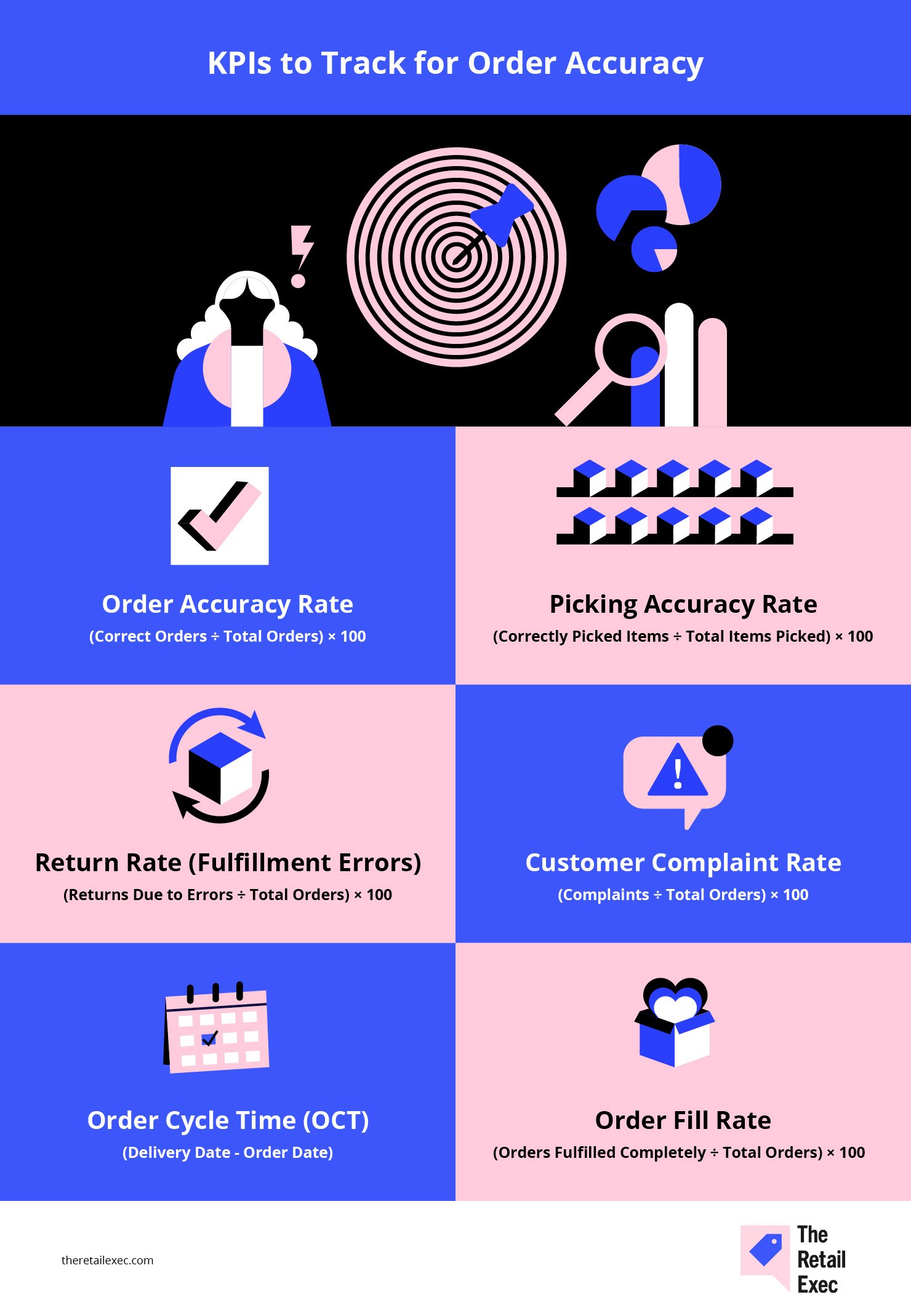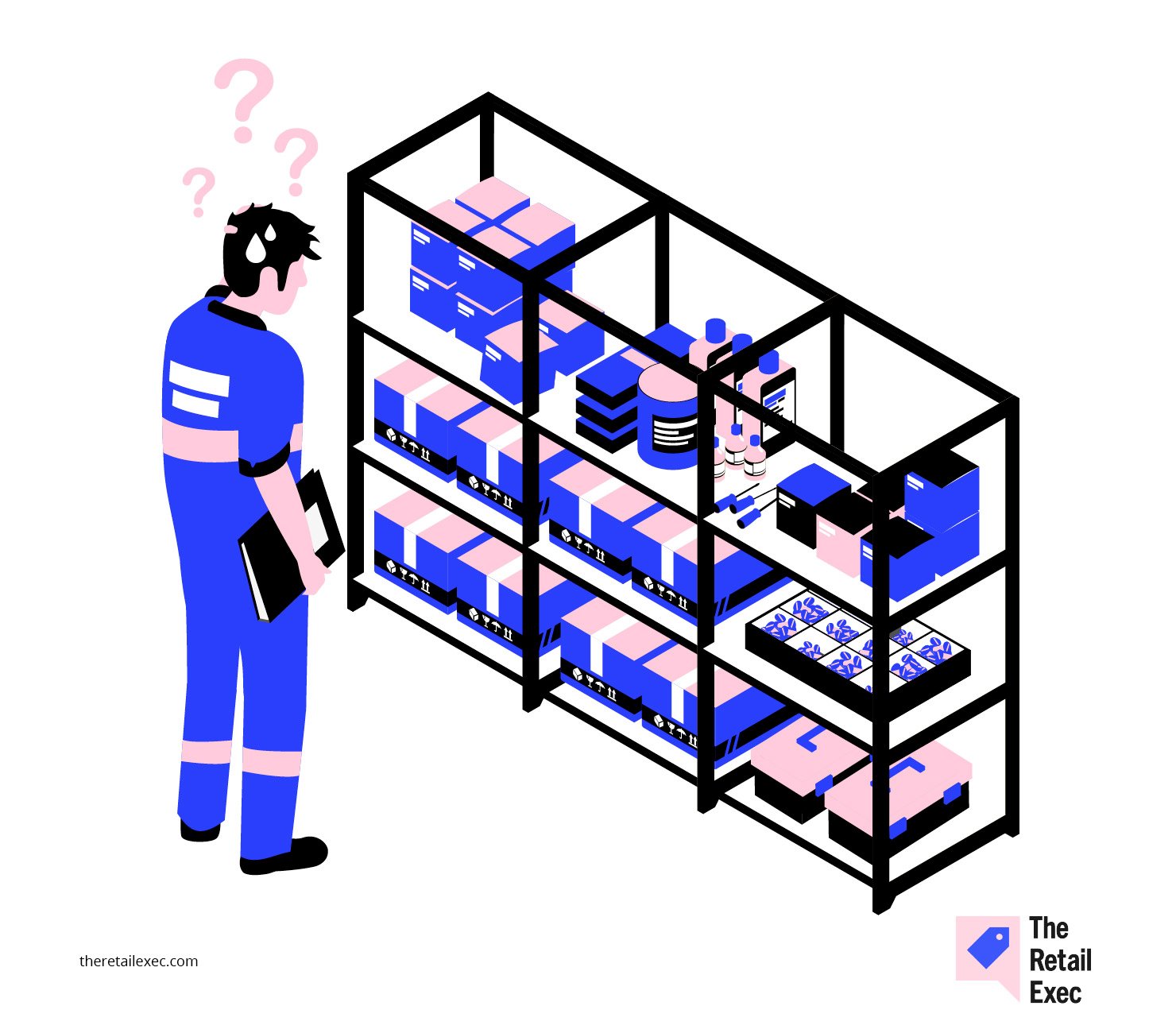Oops-Free Deliveries: Order accuracy is essential in ecommerce, directly affecting customer satisfaction and brand loyalty. It involves ensuring that all items are picked, packed, and shipped correctly, maintaining high trust and reputation.
Ecommerce Trust Foundation: Increased expectations mean even minor fulfillment errors can damage customer relations. Businesses must view order accuracy as core to their strategy to avoid losing repeat customers and damaging their brand.
Metrics Matter Beyond Numbers: Order accuracy isn't just about percentages; it's a key element in providing a top-notch customer experience. Achieving high accuracy helps build trust and encourages repeat business.
Competing for Perfection: With fierce competition and rising consumer expectations, minimizing mistakes becomes crucial. Businesses must focus on accuracy to ensure long-term success and customer retention.
Order Accuracy Decoded: It's more than just logistics; order accuracy is a pivotal element for fulfilling customer needs seamlessly, making it crucial for any ecommerce strategy focused on growth and reputation.
Imagine this: A customer excitedly opens their long-awaited package, only to find the wrong item inside.
Disappointment sets in, frustration mounts, and a potential repeat buyer is lost in an instant.
In the world of ecommerce, order accuracy isn’t just a logistical metric—it’s the foundation of customer trust, brand reputation, and long-term success.
With rising consumer expectations and fierce competition, even a tiny error in fulfillment can have major consequences. But how can businesses ensure near-perfect order accuracy?
In this article, we explore the key methods for tracking accuracy and proven strategies to minimize mistakes.
What is Order Accuracy?
Order accuracy is the percentage of orders picked, packed, and shipped correctly. No missing items, wrong sizes, or unexpected surprises—unless you’re running a mystery box business.
It’s a critical piece of your overall customer experience.
Nothing kills brand loyalty like shipping a blue sweater to a customer who wanted a black one, or worse, forgetting the sweater altogether.
It’s also vital for cost control. Fewer returns and reduced customer complaints translate to lower operational costs.
How to calculate order accuracy rate
The formula for order accuracy rate is refreshingly simple:
Order Accuracy Rate = (Total Correct Orders / Total Orders Shipped) x 100
Almost every modern business tracks order accuracy through software, typically an inventory or warehouse management system. To keep the system honest, you can also add cycle counts and random order checks.
What is a good order accuracy rate?
100% is a good accuracy rate, so that’s what you should strive for.
I asked Martin Cox, the founder of Glazing Supplies Direct, a niche online store that sells glazing packers for windows and doors in the UK, about their order accuracy rate.
“We aim for 100% accuracy and achieved a little over 99.5% accuracy rate over the past year with 14,000 orders,” Mark said.
One message to take from Mark’s comment? Order accuracy is table stakes, not a competitive edge. In fact, Mark added that he aims to achieve 99.7% accuracy as they scale further to 20,000 orders.
However, if you’re at over 95%, you’re not at a competitive disadvantage to competitors. You’ll still be able to stay in the game, but you’ll need to make changes fast.
Of course, there are various factors to consider when thinking of a practical order accuracy rate, such as:
- Your industry. If you sell hoodies, you might occasionally get away with shipping an unnoticeably lighter shade of color. If you sell medical products, though, shipping the wrong medicine can be catastrophic.
- Your order volume. The absolute number of errors grows as you scale up if your processes aren’t right. While the order accuracy rate might remain more or less the same, you’ll have more unhappy customers, which translates to more bad publicity.
- Your fulfillment method. In-house fulfillment gives you more control. 3PLs offer greater efficiency but can vary in accuracy. Weigh the pros and cons of both in your business’s context before choosing.
KPIs related to order accuracy that you should be tracking

Order accuracy rate gives you a big-picture view. However, various other KPIs can help you spot where the problem lies when your order accuracy rate starts dropping.
Here’s what you should track:
- Order accuracy rate: Yep, of course we have this metric above all others. It serves as your trigger. If it drops, check other KPIs to see where the problem lies.
- Picking accuracy rate: Your team (or warehouse robots) must pick the correct item before an order is packed and shipped. If they mess up, the entire order will be wrong before it even leaves the warehouse.
Picking Accuracy Rate = (Correctly Picked Items / Total Items Picked) x 100
- Return rate (due to fulfillment errors): Returns aren’t always your fault, but if too many items were returned because they were wrong or missing, that’s a fulfillment problem.
Return Rate (Due to Fulfillment Errors) = (Returns Due to Mistakes / Total Orders Shipped) x 100
- Customer complaint rate: Your accuracy must improve if customers call you out on mistakes before you catch them. A customer complaint rate suggests your mistakes are causing customer disappointment, which is terrible for your topline in the long run.
Customer Complaint Rate = (Order Related Complaints / Total Orders) x 100
- Order cycle time (OCT): OCT doesn’t directly measure accuracy, but it’s still relevant. If ensuring accuracy significantly slows down your delivery speed, competitors offering next-day fulfillment will eat your lunch.
OCT = Order Delivery Date - Order Placement Date
- Order fill rate: The fill rate shows how many orders are shipped in full. If this percentage drops, the reason could be backorders or stockouts, which are both bad news. It’s also your cue to look into inventory management and fulfillment processes to see if there are inefficiencies you need to iron out.
Order Fill Rate = (Orders Fulfilled in Full / Total Orders Placed) x 100
Common Causes of Order Inaccuracies (and How to Fix Them)
Most causes of order inaccuracies are preventable. If you’re dealing with low order accuracy, here are potential causes to look into and a quick overview of fixes:
Human error (AKA: humans being human)
Your team might make mistakes when picking, packing, or entering order data. For example, your team might pack the wrong item or quantity or forget to pack an item altogether.
Here’s how you can eliminate errors from your processes:
- Get smarter gear. Barcode scanners automate SKU entry and verify that your warehouse crew picks exactly what customers ordered—no more wondering why someone got a swimsuit instead of snow boots.
- Lean on AI. Use an AI-powered order management system that checks every detail before an order is shipped. Since robots aren’t distracted by text messages, they’re less likely to pack sunglasses when a customer orders a jacket.
- Invest in training. Train humans to use technologies like AI and barcode scanners effectively, instead of training them not to make mistakes.
Overcomplicated SKUs
Does your product catalog look like a nightmare of similar SKUs? Avoid unnecessary SKU variations and stick to a standard to reference a color, size, or weight.
Variations make finding the right SKU excruciatingly frustrating and confusing for your team—leading directly to mistakes.
Example: Suppose you sell blue and navy-colored t-shirts using the SKUs TSHRT-BLU and TSHRT-NVY.
Your team receives a new shipment that's just slightly darker than your standard navy—more like midnight blue. The person managing inventory creates a new SKU (TSHRT-MDBL).
But unless you actually offer midnight blue as a separate color option on your storefront, this variation adds needless complexity. Instead, stick with the original navy SKU (TSHRT-NVY) to keep things simple and error-free.
Here are some easy fixes:
- Use clear SKU naming conventions. Avoid unnecessary variations. The fewer the SKUs, the better.
- Use high-quality product images. Makes it easier for pickers to differentiate between similar items.
This adds a visual inspection layer to the picking system.
If the picker is holding a light blue t-shirt and sees a navy blue t-shirt in the order management system, they’re likely to recognize the difference and double-check the color before packing.
Old-school inventory management
Your spreadsheet says you have stock, but when you go to the warehouse to pick up the item… poof! It’s gone.
The reason? Errors.
Errors are inevitable if you manually update inventory—fat finger errors, a sleepy bookkeeper, or arithmetic mistakes can all lead to accepting orders for out-of-stock items.
These errors are costly. Overselling and backorders cause delays, cancellations, and angry customers, which means errors have a direct and pronounced impact on revenue in the long term.
Fix it by:
- Tracking inventory in real-time. Ditch the ancient spreadsheet and switch to an AI-powered inventory management system. It will give you real-time visibility over inventory levels across warehouses and stores.
- Scheduling regular cycle counts. This is where manual effort shines. Have your team conduct regular audits to ensure the digital records match reality. An audit is also a great way to detect fraud and collusion.
- Automating inventory processes. Real-time visibility isn’t the only good thing about inventory management software. The top ones can automate most parts of the process, such as generating a purchase order when inventory reaches a defined threshold and syncing inventory across sales channels.
Interestingly, Mark mentioned they don’t use any inventory management software.
While a 99.5% order accuracy rate sounds impressive, even too good to believe, when there’s no automated system backing the process, Mark explained he has a system that works for them.
We make our inventory system super easy to follow, so much so that it’s hard to go wrong, even though we have over 500 SKUs.
Mark’s success goes to show you can manage inventory effectively without software and achieve high accuracy.
However, it’s a risky proposition. It leaves you vulnerable to a range of errors that you only recognize once it reaches your customers (i.e., after the damage is done).
Automated systems are like insurance against these errors, except that they also generate returns by making your processes more efficient and lowering your costs.
Poor warehouse organization

Every order is like a treasure hunt no one wants when inventory items are scattered, mislabeled, or stored inefficiently. It’s also a recipe for an error-prone picking process.
Mislabeling is a big one, according to Mark:
Inaccurate labeling is the #1 cause of issues for us.
Picking and packing works fine, but if items are labeled incorrectly, we’re just packing the wrong items.
If that sounds relatable, you need a complete overhaul of your warehouse.
Here are some basics to start with:
- Optimize slots. Store fast-moving products in locations that are easier to reach. For example, stack popular items at the bottom and slow-moving items at the top of the rack.
- Label bin location. Every product should have a clearly marked home, so every pick doesn’t make your team lose patience.
- Optimize the warehouse layout. Redesign the warehouse layout to arrange items based on picking frequency. Just like stacking popular items lower on the rack makes picking easier, arranging them near the entry minimizes unnecessary walking.
When I asked Jeff Wolpov, senior VP of ecommerce at Ryder System, Inc, a 3PL provider, about his observations on the most effective strategy to address picking and packing errors, he had an interesting perspective.
While using software and streamlining processes are great starting points, many ecommerce businesses would benefit even more by focusing on “limiting touches and shortening pick paths to make picking more efficient,” explained Jeff.
Although not non-negotiable, businesses that can afford to should also invest in the hardware side of process automation to minimize errors. About this, Jeff says:
Where it makes sense, integrate robotic picking systems, batching and waving processes, slotting, put walls, automated sorting, and conveyor belt systems to streamline order processing.
A combination of these can massively reduce picking errors or eliminate them altogether in some cases.
Why Order Accuracy Matters
It matters because order accuracy directly impacts your revenue, retention rates, and reputation. Let’s dive deeper and look at why order accuracy is mission-critical for your business. With greater order accuracy, you:
- Reduce cost. Every mistake has a price tag. Order errors lead to returns, reshipping, and wasted labor. Processing returns can cost retailers up to 66% of an item’s original price, reports CNBC. Eliminating just the return costs can justify the time and money you invest in improving order accuracy.
- Minimize waste. Incorrect orders lead to wasted packaging material, transportation emissions, and discarded returned items, contributing to landfills. This is an even bigger problem if you’re striving to be an eco-friendly brand.
- Improve operational efficiency. Order mistakes slow down your fulfillment process, and fixing these mistakes steals time from fulfilling new orders. Think about the time spent re-picking, repacking, dealing with the logistical mess, and communicating with customers. It’s a laundry list of additional expenses.
- Increase customer satisfaction. Customers are often eager to receive orders. They feel frustrated when they receive the wrong item or receive it a lot later. You can deal with a return by spending money, but the bad review they’ll leave? It’s hard to recover from that. You might also lose that customer—32% will leave a brand they love after just one bad experience.
- Identify improvement areas. Poor order accuracy is often a symptom of a bigger problem—this could be an inventory, warehouse, or training issue. A quick audit of inventory data and warehouse processes can reveal the problem and help you fix your low order accuracy as well as the bigger problem causing it.
6 Strategies to Improve Your Order Accuracy
Improving order accuracy can feel daunting because it involves tweaking processes deeply ingrained in your team. Let’s dive into the most effective strategies to improve order accuracy.
Choose a combination of these based on the cause of low order accuracy in your business or areas where you believe there’s room for improvement.
Start with accurate inventory management
Inventory discrepancies are the root cause of most fulfillment nightmares.
It’s what makes retailers accept orders for items that aren’t in stock, fail to deliver on time, and overstock slow-moving products.
Poor inventory management also translates to poor inventory data. Mispicks, stockouts, and overselling are unavoidable when your team makes decisions based on bad intel.
That’s why most retailers use inventory management software. It’s the only way to not be in a situation where you have to tell a customer, “Oops, we actually don’t have that,” after they place an order.
Looking for an inventory management system? Here are the best ones on the market:
Unfortunately, even the best systems aren’t foolproof.
If the warehouse manager has sneaked a few high-value items out of inventory by colluding with a team member, your inventory software won’t reflect that.
That’s why regular audits are non-negotiable.
Consider cycle counting if a complete inventory count doesn’t make sense because you don’t have the resources or bandwidth to slow things down at the warehouse.
Cycle counting is a continuous, part audit where you rotate through inventory sections for counting.
High-value or fast-moving products are counted more frequently, and vice versa. This helps catch problems early and prevent them from snowballing into stockouts, mispicks, and overselling.
Optimize warehouse organization for better picking accuracy
Picture your work desk with pens, papers, a mesh of wires, and your sanity scattered across the desk.
Now, imagine looking for the wire connecting your keyboard and CPU. It’s possible, but you’ll likely pull on the wrong wire several times.
Unorganized warehouses have the same problem. They cause your team to lose patience, leaving them vulnerable to mistakes.
To make it easier, optimize your warehouse layout.
Here are a few ideas you can implement:
- Stack fast-moving items closer. Store your bestsellers closest to the packing station. Low-turnover SKUs can sit further back.
- Group SKUs that are frequently bought together. If customers frequently buy shoe polish with formal shoes, store them close to each other to reduce unnecessary movement.
- Create logical zones. Creating zones based on demand level may not always seem logical. For example, if you sell men's apparel, you might have several SKUs with similar demand levels. If that’s the case, divide the warehouse into clearly defined sections based on product type or size.
- Design efficient pick paths. The fewer steps pickers take, the fewer mistakes they make. For example, pickers can follow a zigzag path down aisles instead of backtracking if you use a serpentine layout. You might also consider assigning specific sections to different pickers to reduce congestion and errors. Some warehouse management systems also help pickers find the fastest pick route.
Need help choosing a warehouse management system? Here are our top picks:
Use barcode scanning and RFID for precise order-picking

It’s natural for a tired warehouse worker to grab the wrong SKU or miscount items occasionally. That’s what barcode scanning and RFID are for. It takes human error out of the equation.
Follow a simple rule: Anything that’s not scanned doesn’t move.
Barcode scanning
Here are a few things to keep in mind if you plan to use barcode scanning in your process:
- Label everything properly. Label every product with a clearly printed, high-contrast barcode (or QR code) that scanners can read instantly. No faded labels. No smudged ink. No missing barcodes.
- Scan at every stage. A scan is required at every step—picking, packing, and shipping. If an item doesn’t match the order, the system should flag it before it leaves the warehouse.
- Use handheld or wearable scanners. These speed up the process and reduce handling errors compared to manual verification.
- Automate error-checking. Many WMS solutions allow you to configure alerts that notify workers when they scan the wrong item. Use these alerts to keep mistakes from reaching your customers.
Radio frequency identification (RFID)
If you’re open to investing more, RFID is a superior alternative to barcodes because it helps:
- Scan hundreds of items at once. While barcodes require line-of-sight scanning, RFID tags can be read wirelessly in bulk, so there is no need to scan each item individually.
- Automate cycle counts. RFID eliminates the need for manual cycle counts. RFID scanners can sweep an entire warehouse aisle and verify stock levels in seconds.
- Prevent shrinkage. If a product is removed from a location without authorization, RFID detects the removal, helping you prevent theft and misplacement.
Automate fulfillment processes to reduce human error
Manual fulfillment is like playing a game of telephone. Every step adds another opportunity for errors. Automating your fulfillment eliminates human error.
There’s no dearth of hardware and software automation tools.
Here’s a quick overview of some tools you can use:
- Robotic picking: While OMS acts as the brain, automated picking systems like robotic arms act, quite literally, as hands. They retrieve items based on order data received from the OMS and make zero mistakes. They’re pretty expensive, so do a cost-benefit analysis before investing. It’s generally favorable for large businesses.
- Automated sorting: Automated sorting systems are even more expensive. They use a combination of software and hardware to sort items into correct bins, route packages to the right packing station via conveyor belts, and dynamically optimize the sortation based on volume and priority.
- Order management systems (OMS): OMS automates almost every part of the process, including order verification, choosing the best fulfillment center based on stock levels and proximity to the customer, and ensuring that robotic pickers (if you use them) work off the most up-to-date order data.
If you’re looking for help choosing the best OMS, here are our top picks:
Implement quality control measures before shipping
No matter how airtight your fulfillment processes are, an occasional error can slip through and tarnish the reputation you’ve been working hard to build.
Quality control measures can filter out these occasional errors and make your deliveries error-proof.
Here are some quality control measures you can take to tie up any loose ends:
- Double-check items when they’re picked and packed. Unless your warehouse is fully automated, you need to verify every item before moving it to packing. Use barcode scans to confirm the correct item was picked and in the right quantity. Repeat the scan at the time of packing.
- Use weight-based verification. Weight-based verification can often flag discrepancies such as wrong, missing, or extra items packed, as well as fraudulent returns. If you’re shipping an order for a wireless mouse that weighs 0.25 lbs, but the picker accidentally packs a wireless keyboard that weighs 1.5 lbs, the weight discrepancy can flag the error.
- Conduct randomized quality control audits. Randomly pull completed orders and run a manual inspection before shipping, especially if you see errors even after adding multiple layers of checks. Track recurring error patterns—are there frequently mispicked SKUs or a particular shift making more mistakes? Take the steps necessary to fix the problem, which may involve training, improving warehouse processes, or fixing system blind spots.
Continuously improve with audits, training, and customer feedback
Automation is an excellent solution, but not always viable for small businesses.
As long as humans play a role in your fulfillment process, you must invest in training and conduct regular audits.
For example, you can periodically place a “mystery order” to evaluate accuracy in a low-stakes setting and reinforce best practices. If you notice room for improvement, work on it during the next training session.
Customer support is also a great source of intel on areas where your team could use additional training.
Start by investigating the root cause of poor feedback. For example, if the most common complaint is that the “wrong item was received,” check if the product packaging looks similar to another, as this is a common picking error.
Pick a Strategy That Works For Your Brand
You can add dozens of layers to your processes to improve order accuracy. But it all boils down to efficient processes, intelligent software, and powerful hardware.
Most companies do well with just well-designed processes and intelligent software. That’s where most of this guide focuses because it’s easier for small and medium-sized businesses to improve processes and implement software solutions than to invest in expensive hardware.
If you’re a large enterprise or on the path to becoming one, investing in hardware is an excellent way to scale as orders multiply.
However, once you’ve done what’s in your budget, it’s best to focus your marginal efforts on subtly dealing with errors instead of investing without a favorable cost-benefit ratio.
As Julie Cheney, the VP of Retail at enVista, a leading supply chain strategy and enterprise technology consulting firm, explains:
While striving for perfection is best practice, retailers should dedicate their people, processes, and technology toward implementing systems that will quickly and efficiently recover the small percentage of incorrect orders.
Retail never stands still—and neither should you. Subscribe to our newsletter for the latest insights, strategies, and career resources from top retail leaders shaping the industry.
Order Accuracy FAQs
Below, we answer some common questions about order accuracy.
What is the most common cause of incorrect orders?
Human error in picking and packing is the most common culprit. When employees manually select items in a fast-paced warehouse or retail fulfillment center, mistakes happen.
Technologies like RFID, barcode scanning, and AI inventory management software can significantly reduce human errors.
How often should businesses audit their inventory for accuracy?
The ideal audit frequency depends on your order volume, SKU complexity, and fulfillment speed. As a general guide, consider running cycle counts weekly and a full inventory audit at the end of every quarter or year.
What role does SKU labeling play in order accuracy?
SKU labels are like GPS for your warehouse, helping pickers find the right item for every order. They also give each item a scannable identity, helping your team verify the accuracy of each order before it’s shipped.
How can small businesses improve order accuracy without automation?
Here’s what you can do to improve order accuracy without automation:
Standardize your picking and packing process
Organize your inventory in the warehouse to support quick picking and packing Label all SKUs clearly
Set up dedicated packing stations with all materials in one place.
Implement a manual order verification system
What’s the difference between order accuracy and order fulfillment rate?
Order accuracy measures how often customers receive exactly what they ordered—the right items, in the right quantity, and in good condition. The order fulfillment rate measures the percentage of orders successfully shipped out compared to the total number of orders received.


